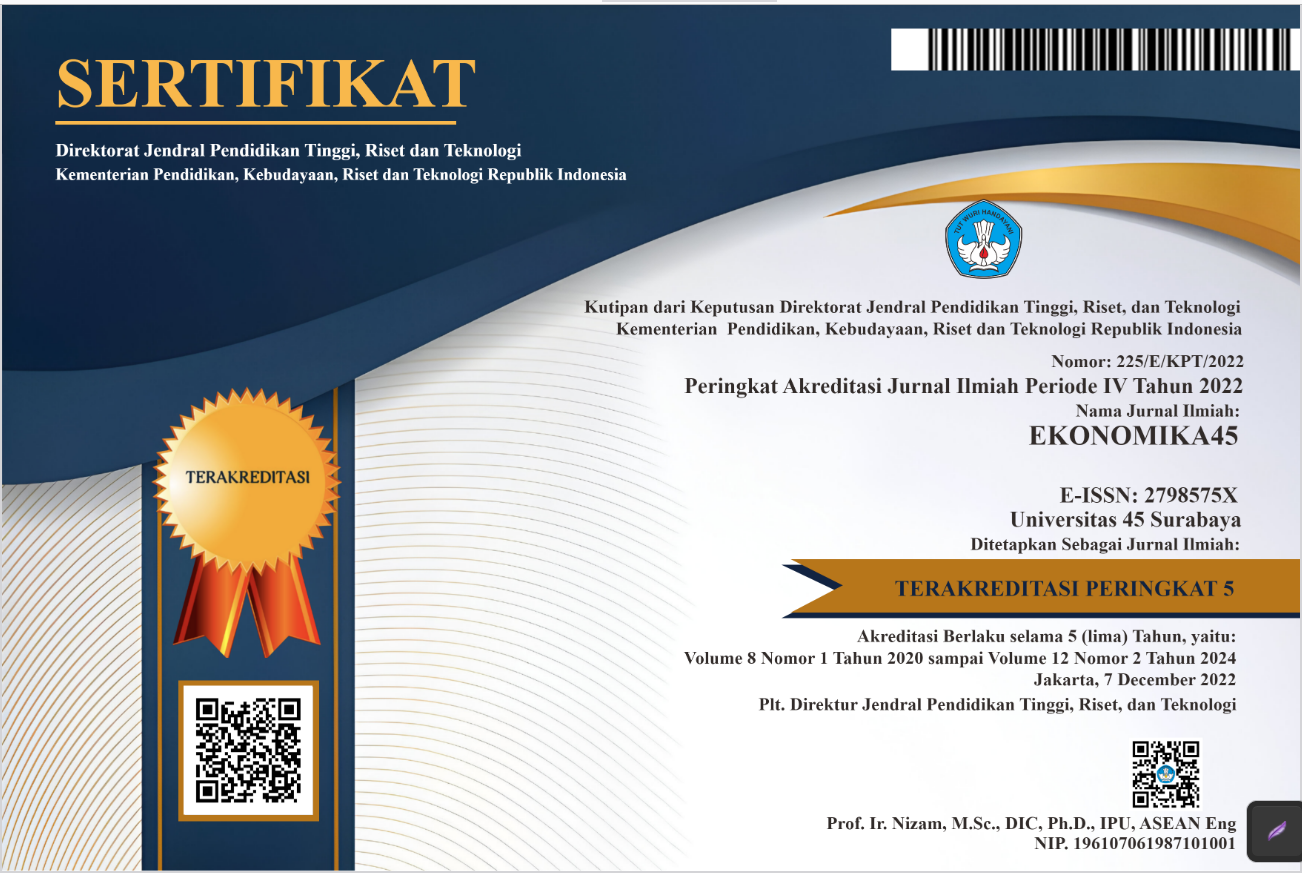PENINGKATAN HASIL BELAJAR JURNAL PENYESUAIAN MELALUI MODEL PEMBELAJARAN LANGSUNG DENGAN PENDEKATAN FLIPPED CLASSROOM
DOI:
https://doi.org/10.30640/ekonomika45.v10i2.978Keywords:
direct instruction, flipped classroom, learning outcomesAbstract
This research aimed to find out the increasing of learning outcomes in adjusting journal entry, the teacher’s activities of instructional management, and the student’s activities in learning process at XII-IPS3 classes of SMA Negeri 3 Tarakan in the academic year 2021/2022. The type of this research was classified as Classroom Action Research (CAR) by applied the direct instruction by the flipped classroom approach. The result of this analysis showed that both teacher’s and student’s activities indicated gradual increases in the three cycles. Student’s learning outcomes also went up in each cycle. The observation of teacher’s activities in the first cycle was 3,78 and become 4,12 in the second cycle, and went up to 4,43 in the third cycle while in observation of student’s activities in the first cycle was 2,95 and become 3,45 in the second cycle and went up to 3,60 in the third cycle. Classically, passing rates in the first cycle was 41,66% and in the second cycle, it increased by 69,44% and went up to 88,89% in the third cycle. The strength in learning by the direct instruction and the flipped classroom approach were it can improved teacher’s activities, student’s activities and learning outcomes. While the weaknesses were it need more time to prepare the subject, and the student with inadequacy in motivation unable to follow the lessons. Based on the result of this research it could be inffered, the direct instruction and the flipped classroom approach are eligible in improving the student learning outcomes in adjusting entries
References
Arends, Richard. I. 2010. Learning To Teach. New York : Published by McGraw-Hill.
Arikunto, S. 2001. Dasar-Dasar Evaluasi Pendidikan. Jakarta : Bumi Aksara.
Baker, Wesley. (2000). Flipping the Classroom :Revolutionising Legal Research Training.Cambridge Journal. Vol 13, pp 231-235.
Bergman,J.,&Sams,A. 2012. Flip Your Classroom : Reach Every Student In Every Class everyday. United States, America : International Society for Technology in Education
Eggen, Paul & Kauchak, Don. Strategi dan Model Pembelajaran, (Jakarta Barat : Indeks, 2012
Flip Learning Network, (2014). Article:”Definiton of four pillar flipped classroom”. March, ( http://www.fliplearning.org )
Gronlund, Norman, E. 1998. Constructing Achievement Test. Third Edition . London : Prentice Hall.
Hergenhahn, B.R. & Olson, Matthew H. 2010. Theories of Learning. Penerbit : Kencana Prenada Media Group. Jakarta
Koshy, Valsa. 2005. Action Research For Improving Practice. London : Paul Chapman Publishing.
Lilis, Puspitawati dan Sri Dewi Anggadini. 2011. Sistem Informasi Akuntansi. Jakarta : Graha Ilmu.
Lo, Chung Kwan & Hew, Khee Foon. 2017. A critical review of flipped classroom. Research and Practice in Technology Enhanced Learning.challenges in K-12 education : possible solutions and recommendations for future research page 1-22
Maolidah, Irna Septiani. 2017. "Efektivitas Penerapan Model Pembelajaran Flipped Classroom Pada Peningkatan Kemampuan Berpikir Kritis Siswa". Edutechnologia, Tahun 3, Vol 3 No.2 hal.162-170
Mashudi. 2013. Desain Model Pembelajaran Inovatif Berbasis Konstruktivisme. Tulungagung:STAIN Tulungagung Press
Nur, M. 2002. Pemotivasian Siswa Untuk Belajar. Surabaya : Unesa.
Panjaitan, Dedy Juliandri. 2016. "Meningkatkan Hasil Belajar Siswa Dengan Metode Pembelajaran Langsung". Jurnal Mathematic Paedagogic Vol I No.1 hal.83-90
Patandean, Yulius Roma & Indrajit, Richardus Eko. 2021. Flipped Classroom : Membuat Peserta Didik Berpikir Kritis, Kreatif, Mandiri, dan Mampu Berkolaborasi dalam Pembelajaran yang Responsif. Yogyakarta : Penerbit Andi
Pribadi,Benny A. . 2009. Model Desain Sistem Pembelajaran. Penerbit : Dian Rakyat. Jakarta.
Ratumanan , T. G. & Laurens T. 2011. Penilaian Hasil Belajar pada Tingkat Satuan Pendidikan”. Surabaya : Unesa University Press.
Riyanto, Yatim . 2005. Paradigma Pembelajaran. Penerbit : Unesa University Press . Surabaya.
Sani, Ridwan Abdullah.2013. Inovasi Pembelajaran. Jakarta : PT Bumi Aksara
Siga, Robertus Romy. 2020. "Improvement Of Work Paper Learning Outcomes through Contextual Approaches and Problem-Posing Methods in SMA Negeri 3 Tarakan". International Journal of Multi Discipline Science (IJ-MDS) Vol.3 No.1. Page 8-21
Slavin, Robert E. 2006. Educational Psychological. Boston : Pearson
Sudjana, Nana. 2009. Penilaian Hasil Proses Belajar Mengajar. Bandung : Remaja Rosdakarya.
Sudjana.2002. Metode Statistik . Bandung : Tarsito
Sugiyono. 2008. Metode Penelitian Pendidikan. Bandung : Alfabeta
Suherman, E. 1996. Petunjuk Praktis Untuk Melaksanakan Evaluasi Pendidikan Matematika. Bandung : Wijayakusumah
Sukardi.2009. Masalah Kebaruan Dalam Penelitian Teknologi Industri Pertanian. Jurnal Teknologi Industri Pertanian Vol 19 (2) , Pp 115-121
Trianto, M.Pd. 2009. Mendesain Model Pembelajaran Inovatif - Progresif. Penerbit : Kencana Prenada Media Group. Surabaya.
Trianto. 2010. Mendesain Model Pembelajaran Inovatif – Progresif. Jakarta : Kencana
Undang-Undang Sistem Pendidikan Nasional No.20 Tahun 2003.









